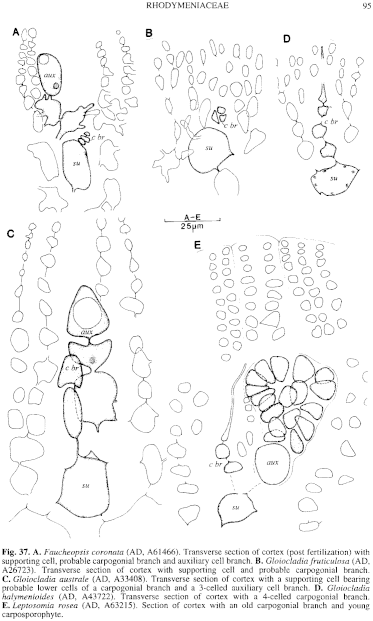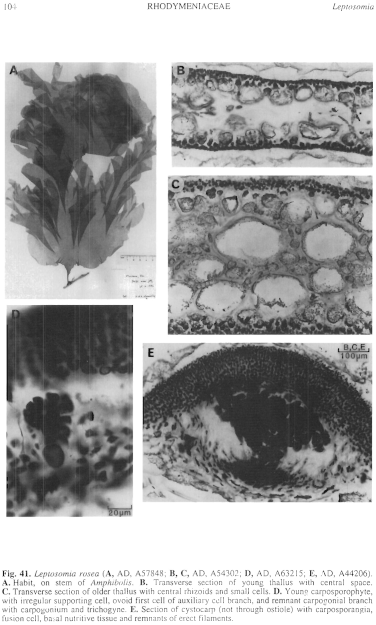|
|
|
|
|
|||||||||||
|
Electronic Flora of South Australia Species Fact Sheet
Phylum Rhodophyta – Class Florideophyceae – Order Rhodymeniales – Family Rhodymeniaceae
Synonyms
Rhodymenia ?rosea Harvey 1855a: 554.
Halymenia cliftonii Harvey 1863, synop.: xlvi (in part).
Chrysymenia cliftonii J. Agardh 1876: 319. Sonder 1881: 18.
Leptosomia cliftonii (J. Agardh) J. Agardh 1892: 88. Irvine & Guiry 1986: 297. Kylin 1931: 19, pl. 5 fig. 11. May 1965: 409.
Sebdenia cliftonii (Harvey) De Toni 1900b: 533.
Chrysymenia gelatinosa J. Agardh 1890: 24. Tisdall 1898: 506. Wilson 1892: 179.
Leptosomia gelatinosa (J. Agardh) J. Agardh 1892: 88. Kylin 1931: 20, pl. 5 fig. 12. May 1965: 409.
Sebdenia ?gelatinosa (J. Agardh) De Toni 1900b: 532.
Thallus (Fig. 41A) rose-red, delicate, soft and mucilaginous, 15–50 cm high, foliose or usually with axes 3–9 cm broad bearing numerous marginal overlapping lobes for 1–2 orders, lobes 1–15 cm long and 2–8 cm broad, basally broader or somewhat contracted, rounded or tapering to a blunt apex, margin often with minute excrescences; young thallus 90–300 µm thick, becoming 0.5–1 mm thick near the base. Holdfast 2–5 (–10) mm across, usually surrounding Amphibolis stems, with a terete to compressed stipe 0.5–2 cm long; epiphytic or possibly epilithic. Structure multiaxial, developing a cortex 1–2 cells thick, outermost cells in slight rosettes over inner cells (Fig. 42A, B, D), cells ovoid, 4–6 µm in diameter and a large-celled medulla with 1 (–2) ovoid cells 50–90 µm in diameter on each side of a central space (Fig. 41B) within which sparse branched rhizoids 7–14 µm in diameter, cells L/D 2–8, develop; in older parts (Fig. 41C) the rhizoids increase to fill the central space with intermixed large and small cells, with the original medullary cells becoming thick-walled (10–20 µm), 120–200 µm in diameter, and with numerous secondary pit-connections. Rhodoplasts ovoid, in chains in inner cells.
Reproduction: Gametangial thalli dioecious. Carpogonial branches (Fig. 41D) 3-celled, borne on inner cortical supporting cells (Fig:37E), together with a 2-celled auxiliary cell branch (Fig. 41D). Carposporophytes (Fig. 41E) with a basal, erect, fusion cell producing 2–4 dense lobes of carposporangia each 20–30 µm in diameter; basal nutritive tissue slightly concave, erect filaments not apparent. Cystocarps (Fig. 42A) scattered, 0.5–1 mm across and 250–600 µm high, immersed in the thallus but slightly protruding, with a distinct surface pericarp (Fig. 41E) of anticlinal rows of 6–10 small cells and a small central ostiole 30–60 µm in diameter. Spermatangia (Fig. 42B, C) covering the thallus, cut off directly or via initials from outer cortical cells, ovoid, 1–2 µm in diameter.
Tetrasporangia (Fig. 42D, E) scattered, intercalary, transformed from inner cortical cells and with pit-connections to outer cortical cells, subspherical to ovoid, 30–55 µm long and 20–45 µm in diameter, cruciately divided.
Type from Fremantle, W. Aust. (Clifton); lectotype (here designated) in Herb. Harvey, TCD (Tray. Set 347), with a second specimen in TCD placed (by Harvey ?) under Halymenia cliftonii.
Selected specimens: Yanchep, W. Aust., drift (Womersley, 22.ix.1979; AD, A51274). Safety Bay, W. Aust., drift (Womersley, 18.viii.1979; AD, A50770 (on Amphibolis?) and 29.ix.1979; AD, A50736). Head of the Great Australian Bight, S. Aust., drift on Amphibolis (Parsons, 4.xi.1968; AD, A34183). Pearson Is, S. Aust., 50 m deep (Shepherd, 9.i.1969; AD, A33872). Elliston, S. Aust., 6 m deep in shade (Shepherd, 24.x.1969; AD, A34784) and 10 m deep in bay (Shepherd, 18.x.1973; AD, A44206). Point Avoid, S. Aust., drift (Womersley, 2.xii.1975; AD, A46916). Vivonne Bay, Kangaroo I., S. Aust., 0.5–2 m deep on jetty piles (Kraft, 15.vii.1972; AD, A42540). Seal Bay, Kangaroo I., S. Aust., drift (Womersley, 29.x.1966; AD, A31062 and 6.i.1990; AD, A60134). Cape Jaffa, S. Aust., drift, epiphytic (Womersley, 10.xii.1991; AD, A61563). Robe, S. Aust., 1–2 m deep on Amphibolis near jetty (Womersley, 12.ix.1983; AD, A54302) and drift on Amphibolis (Womersley, 30.x.1993; AD, A63215). Hinders, Vic., drift on Amphibolis (Womersley, 25.x.1986; AD, A57848 -"Marine Algae of southern Australia" No. 371).
Distribution: Yanchep, W. Aust., to Flinders, Vic.
Taxonomic notes: Leptosomia rosea is most commonly epiphytic on the stems of Amphibolis, rarely on other algae (e.g. Acrocarpia), but is probably also epilithic. It is confined to rough-water coasts, usually in deep water or shaded situations.
Rhodymenia? rosea Harvey was described from two specimens of Clifton (in Herb. Harvey, TCD) though in his description Harvey refers to "only a single immature specimen" - perhaps it was subdivided. The Tray. Set specimen in TCD is chosen as lectotype and shows the typical sectional structure described above. In TCD there are three large mature specimens of Clifton, dated 1858 and 1859, one of which is also annotated "Leptosomia rosea". Thereafter the epithet rosea was lost sight of, not being given by Harvey (1863) in his synopsis nor by J. Agardh or De Toni. In describing Halymenia cliftonii in 1859, Harvey replaced his earlier name H. kallymenioides of 1855 [now Cryptonemia kallymenioides (Harvey) Kraft], but in 1863 (synop.: xlvi) he confused plants of Leptosomia cliftonii with it. J. Agardh (1876, p. 319) realised this and renamed the latter as Chrysymenia cliftonii J. Agardh, transferred in 1892 to Leptosomia. Using the earliest name, the species is now to be known as Leptosomia rosea (Harvey) Womersley.
L. rosea is variable in form, and includes the habit of L. gelatinosa (J. Agardh) J. Agardh, described from a Wilson specimen from Western Port, Vic. (24.i.1885); the lectotype (Kylin) is in Herb. Agardh, LD, 26637.
References:
AGARDH, J.G. (1876). Species Genera et Ordines Algarum. Vol. 3, Part 1 — Epicrisis systematis Floridearum, pp. i-vii, 1–724. (Weigel: Leipzig.)
AGARDH, J.G. (1890). Till algernes systematik. Acta Univ. lund. 26(3), 1–125, Plates 1–3.
AGARDH, J.G. (1892). Analecta Algologica. Acta Univ. lund. 28, 1–182, Plates 1–3.
DE TONI, G.B. (1900b). Sylloge Algarum omnium hucusque Cognitarum. Vol. 4. Florideae. Sect. 2, pp. 387–776. (Padua.)
HARVEY, W.H. (1855a). Some account of the marine botany of the colony of Western Australia. Trans. R. Ir. Acad. 22, 525–566.
HARVEY, W.H. (1863). Phycologia Australica. Vol. 5, Plates 241–300, synop., pp. i-lxxiii. (Reeve: London.)
IRVINE, D.E.G. & GUIRY, M.D. (1986). Taxonomy of the Rhodyméniales. In T.V. Desikachary (Ed.). Taxonomy of Algae, pp. 287–303, Plates 1, 2. (Univ. Madras: Madras.)
KYLIN, H. (1931). Die Florideenordnung Rhodyméniales. Lunds Univ. Årsskr. N.F. Avd. 2, 27 (11), 1–48, Plates 1–20.
MAY, V. (1965). A census and key to the species of Rhodophyceae (red algae) recorded from Australia. Contr. N.S.W. natn. Herb. 3, 349–429.
SONDER, O.W. (1881). In Mueller, F., Fragmenta Phytographiae Australiae. Supplementum ad volumen undecinum: Algae Australianae hactenus cognitae, pp. 1–42, 105–107. (Melbourne.)
TISDALL, H.T. (1898). The algae of Victoria. Rep. 7th Meet. Aust. Ass. Adv. Sci., Sydney, 1898, pp. 493–516.
WILSON, J.B. (1892). Catalogue of algae collected at or near Port Phillip Heads and Western Port. Proc. R. Soc. Vict. 4, 157–190.
The Marine Benthic Flora of Southern Australia Part IIIB complete list of references.
Publication:
Womersley, H.B.S. (28 June, 1996)
The Marine Benthic Flora of Southern Australia
Rhodophyta. Part IIIB. Gracilarialse, Rhodymeniales, Corallinales and Bonnemaisoniales
Reproduced with permission from The Marine Benthic Flora of Southern Australia Part IIIB 1996, by H.B.S. Womersley. Australian Biological Resources Study, Canberra. Copyright Commonwealth of Australia.
Illustrations in Womersley Part IIIA, 1996: FIGS 37E, 41, 42.

Figure 37 enlarge
Fig. 37. A. Faucheopsis coronata (AD, A61466). Transverse section of cortex (post fertilization) with supporting cell, probable carpogonial branch and auxiliary cell branch. B. Gloiocladia fruticulosa (AD, A26723). Transverse section of cortex with supporting cell and probable carpogonial branch. C. Gloiocladia australe (AD, A33408). Transverse section of cortex with a supporting cell bearing probable lower cells of a carpogonial branch and a 3-celled auxiliary cell branch. D. Gloiocladia halymenioides (AD, A43722). Transverse section of cortex with a 4-celled carpogonial branch. E. Leptosomia rosea (AD, A63215). Section of cortex with an old carpogonial branch and young carposporophyte.

Figure 41 enlarge
Fig. 41. Leptosomia rosea (A, AD, A57848; B, C, AD, A54302; D, AD, A63215; E, AD, A44206). A. Habit, on stem of Amphibolis. B. Transverse section of young thallus with central space. C. Transverse section of older thallus with central rhizoids and small cells. D. Young carposporophyte, with irregular supporting cell, ovoid first cell of auxiliary cell branch, and remnant carpogonial branch with carpogonium and trichogyne. E. Section of cystocarp (not through ostiole) with carposporangia, fusion cell, basal nutritive tissue and remnants of erect filaments.

Figure 42 enlarge
Fig. 42. Leptosomia rosea (A–D, AD, A57848; E, AD, A33872). A. Surface view of cystocarpic thallus. B. Surface view of spermatangial thallus. C. Section of male thallus with spermatangia on cortical cells. D. Surface view of tetrasporangial thallus. E. Transverse section of thallus with tetrasporangia.

|
Email Contact: State Herbarium of South Australia |

|